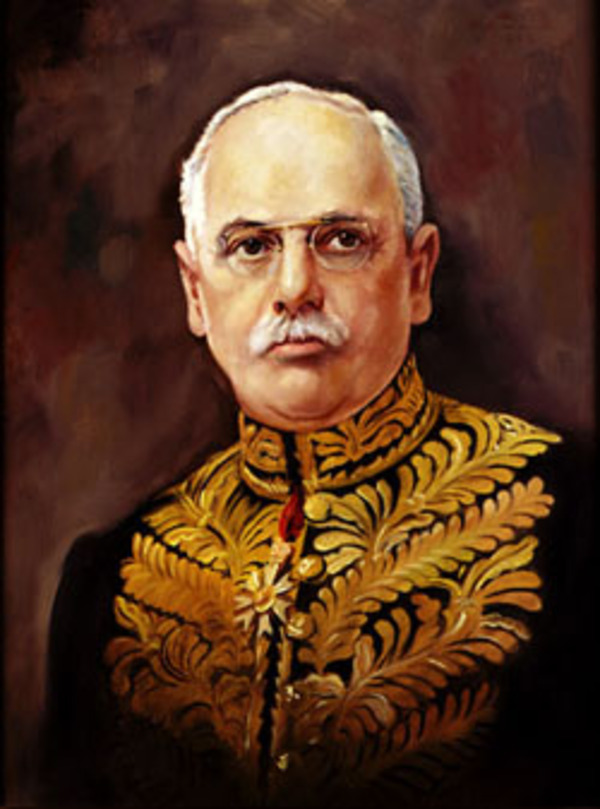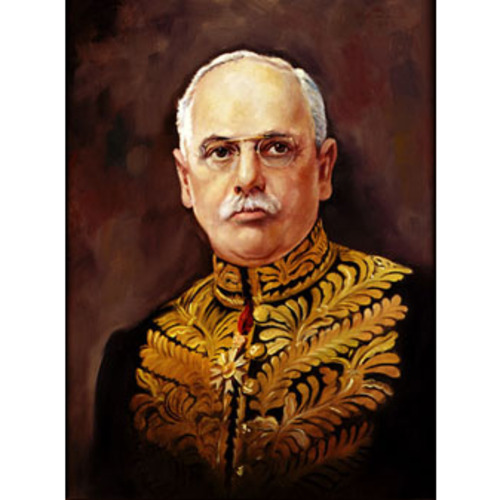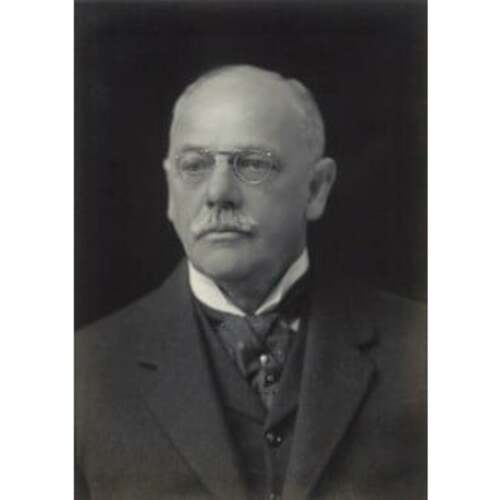
Source: Courtesy of Wikimedia Commons
Barnard, Sir FRANK STILLMAN, businessman, politician, and office holder; b. 16 May 1856 in Toronto, eldest of the three children of Francis Jones Barnard* and Ellen Stillman; brother of George Henry Barnard*; m. 8 Nov. 1883 Martha Amelia Sophie Loewen in Victoria; they had no children; d. there 11 April 1936.
Attracted by the Fraser River gold rush, Francis Jones Barnard travelled to British Columbia in 1859 and sent for his family the following year. In 1861 he became involved in a successful express business that delivered mail between the Cariboo district and Yale, where the family resided before moving to Victoria in the late 1860s. Young Frank Stillman went to the city’s Collegiate School for Boys until he was sent to London, Ont., in 1870 to attend secondary school at Hellmuth College, from which he graduated three years later. By 1874 he had returned to Victoria, where he became a member of the No.2 Company (Victoria Volunteer Rifles) and worked at various jobs, including as an insurance agent and as a clerk for his father’s business, the British Columbia Express Company. When the enterprise was incorporated in 1878, Frank was one of five partners. He became general manager a couple of months before a stroke incapacitated his father in 1881; he was subsequently named president around 1882. When Frank took over the firm, it was in financial crisis, but within two years it had repaid its creditors. In 1886 company partner Stephen Tingley assumed control of the enterprise.
In 1883 Barnard had formed the Victoria Transfer Company, a general transportation firm with the charter for a street railway in Victoria. He managed it from the beginning, and he would be a major shareholder and its president as late as 1896. He joined a syndicate in the mid 1880s to purchase the Hastings Saw Mill on Burrard Inlet, which in turn was sold in 1889 to the Royal City Planing Mills Company [see John Hendry*].
In the 1880s Barnard took over the B X Ranch, which his father had established in 1870 near what would become Vernon. As of 1896 it had grown to 7,000 acres, 700 of them in hay and grain, and 100 in fruit trees. There were also about 250 horses. Barnard expanded his real-estate interests in the interior of the province in 1890, investing in the Okanagan Land and Development Company, formed to develop the Vernon townsite and surrounding agricultural lands. His focus on the region might relate to John Andrew Mara, his brother-in-law, who at the time was the mp for the electoral district of Yale. Also in 1890, with Mara and Captain John Irving, he founded the Columbia and Kootenay Steam Navigation Company, which would operate a fleet of six vessels to serve the Kootenay and Arrow Lakes mining districts. The firm would be acquired by the Canadian Pacific Railway Company around 1897.
In 1889–90 Barnard had been a major shareholder and president of the Vancouver Transfer Company, the secretary and a director of the Vancouver Improvement Company, and a director of the British Columbia Milling and Mining Company and of the Selkirk Mining and Smelting Company. He expanded his mining holdings in the 1890s, promoting and investing in the Lanark Consolidated Mining and Smelting Company. In 1894 he arranged the sale of the gold-mining properties of the Victoria Hydraulic Company to a new firm, the Victoria Consolidated Hydraulic Mining Company, backed by eastern Canadian investors who included William Mackenzie* and Donald Mann. The new company dominated hydraulic gold mining in the Cariboo. Barnard also had large real-estate interests in Nelson, Vernon, Kamloops, Revelstoke, and Three Forks, among other places.
On a trip to Nelson in 1894 Barnard met merchant banker Robert Montgomery Horne-Payne of the English firm of Sperling and Company. He was part of a group of English financiers touring the Canadian Pacific Railway as guests of William Cornelius Van Horne*. Barnard touted investment possibilities in British Columbia, including mining, street railways, and electrical systems. In 1895 he travelled to England and worked with Horne-Payne to seek investment capital for such ventures. Through Sperling and Company they formed a syndicate to supply £300,000 for gold-mining investment, with Barnard becoming the managing director and vice-chairman of Lillooet, Fraser River and Cariboo Gold Fields Limited.
Additionally, Barnard and Horne-Payne formed a syndicate to invest in street railways and electrical systems. By 1891 three British Columbia systems had been established: the National Electric Tramway and Lighting Company (renamed the Victoria Electric Railway and Lighting Company in 1894); the Vancouver Electric Railway and Light Company; and the Westminster and Vancouver Tramway Company. The two mainland companies were funded in part by the Bank of British Columbia and the Yorkshire Guarantee and Securities Corporation, British-based firms active in finance and mortgages in British Columbia. In 1893–94 Sperling and Company issued debentures to fund the Victoria system.
By 1894 both of the mainland railway and electrical companies were in receivership, with significant debt owed to the British firms. The Bank of British Columbia and Yorkshire Guarantee Securities Corporation incorporated the Consolidated Railway and Light Company in April that year, expressly to acquire the Vancouver Electric Railway and Light Company and similar ventures. They approached Barnard, offering to take debentures in the new conglomerate to satisfy their claims (Barnard was already the receiver for both the original Vancouver and the Westminster interests) if he could raise £100,000 in new capital. This was accomplished through the Railway Amalgamation Syndicate organized with Horne-Payne in 1895 in England. In April of that year Barnard, acting for the Consolidated Railway and Light Company, bought both mainland enterprises. The Victoria system then went into receivership, and Barnard purchased it in turn in April 1896 for the newly incorporated Consolidated Railway Company. The provincial act enabling the conglomerate had provided for the merger of the systems in Vancouver, Moodyville (North Vancouver), New Westminster, and Victoria into a single unit, with claimed capitalization of $1.5 million. Barnard became president of the company at the first directors’ meeting on 2 May 1896.
The almost immediate failure of the Consolidated Railway Company is often attributed to the financial damage resulting from the collapse of the Point Ellice Bridge in Victoria on 24 May 1896. An overcrowded streetcar had been crossing it at the time of the disaster, which killed 55 passengers and resulted in several lawsuits. Both at the time and in later accounts, suggestions were made that the Consolidated Railway Company went into receivership as a ploy to avoid paying damages, but apparently the enterprise was in default on interest payments even before the incident. With the added threat of litigation, the Bank of British Columbia and then the Railway Amalgamation Syndicate withdrew their financial support. During this time Barnard continued to pursue capital projects using operational funds, leaving the company in financial distress. The lenders foreclosed in October 1896, with the Consolidated Railway Company’s system continuing to operate under receiver William Farrell of the Yorkshire Guarantee and Securities Corporation. In December 1896 a new British firm, the Colonial Railway and General Investment Company, purchased the Consolidated Railway Company’s assets. They would be sold in turn to the newly formed British Columbia Electric Railway Company (BCER) for £462,000, the reported profit being nearly £50,000.
Horne-Payne and Barnard organized the London-registered BCER in April 1897 specifically to acquire, operate, and improve the railway and electrical assets of the Consolidated Railway Company. Capitalized at £250,000, the new enterprise was to settle with the trustees of the Consolidated Railway Company as well as the British investment companies. Among the first directors of the BCER, in addition to Barnard and R. M. Horne-Payne, were A. C. Mitchell-Innes, R. Northall Laurie, G. P. Norton, J. Horne-Payne, and Rochfort Henry Sperling. Barnard became the resident managing director for a five-year term; all other directors were in Britain.
In 1898 Barnard allocated funds to incorporate the Vancouver Power Company without the board’s authorization. Encouraged to resign, he did so. He remained a company director, but the London-based operation assumed greater control of managerial decisions. In 1905 the board registered the company in British Columbia for the benefit of local shareholders and then appointed Barnard to an advisory committee along with the provincial minister of finance and of agriculture, Robert Garnett Tatlow*, and the mayor of New Westminster, William Holland Keary. They were expected to use their influence on behalf of the company. The committee dissolved in 1911, perhaps owing to perceived conflicts of interest involving Tatlow and Keary. The BCER would be a precursor of the British Columbia Hydro and Power Authority, established in 1963.
While expanding his business interests, Barnard had married Martha Loewen in 1883. She was a daughter of Joseph Loewen, the owner of the Victoria Brewery; Barnard would be named a trustee in 1893 when it became the Victoria-Phoenix Brewing Company. The wedding took place at the Loewen residence, after which the couple was serenaded by a German-language choir, the Victoria Liederkranz. The newlyweds left the next morning for a honeymoon in Portland, Oreg.
Barnard had entered civic politics in 1886, when he was elected as an alderman for Victoria’s James Bay Ward, a position he held for a year. Following in his father’s footsteps, he became a Conservative mp after winning the November 1888 federal by-election for the riding of Cariboo. (His brother would also enter federal politics.) Re-elected in the 1891 federal contest, he served on standing committees responsible for banking and commerce and for railways, canals, and telegraph lines. He did not run in 1896 owing to the pressures of business, which eased somewhat when he resigned as the managing director of the BCER two years later. He ran again in a federal by-election on 28 Jan. 1902, for a seat left vacant in the riding of Victoria, but lost to his Liberal opponent. A Conservative who had backed Sir John A. Macdonald*, Barnard unsurprisingly favoured government support for manufacturers and the resource industries. That year he was a delegate to the Revelstoke convention that established a provincial Conservative Party in British Columbia, and he was named the treasurer of the new group.
In 1906 Barnard retired from most of his business activities (he would serve as chairman of the British Columbia Trust Corporation in 1908). He and Martha took an extended world tour in 1907–8 before returning to Victoria. On 5 Dec. 1914 the Conservative federal government led by Sir Robert Laird Borden appointed Barnard lieutenant governor of British Columbia. He would serve a full five-year term until he was replaced by Edward Gawler Prior on 9 Dec. 1919.
In May 1915 Government House was the target of an attempted invasion by anti-German demonstrators after the sinking of the Lusitania. This action was a response to the rumour that Martha, who came from a prominent family of German immigrants, had celebrated Kaiser William II’s birthday with a party. Troops were called out to prevent an escalation of the situation, a guard was posted to protect Government House, and Barnard issued a formal newspaper denial of German sympathies.
In spite of serving throughout the First World War and the terms of four provincial governments, Barnard’s time in office was uneventful. He was the host for the vice-regal visits to Victoria of the Duke [Arthur*] and Duchess of Connaught in the summer of 1916 and of the Duke of Devonshire [Cavendish] in the autumn of 1917. He entertained the Duke of Connaught again in the summer of 1918, and the Prince of Wales as well as British Admiral John Rushworth Jellicoe in the fall of 1919. At the end of the war Barnard wrote to Prime Minister Borden to request that large cruisers be deployed on the west coast to prevent a socialist uprising led by the Industrial Workers of the World, whose members were distributing literature to returning soldiers. In private correspondence Borden described this proposal as an absurd suggestion, and no action was taken. Barnard’s cumulative service to British Columbia was recognized when he was made a kcmg on 1 Jan. 1918.
After Barnard’s term as lieutenant governor ended, he and his wife returned to Clovelly, their family home overlooking Victoria Harbour. Continuing his limited business activities, he was the president of Evans, Coleman, and Evans, and he was involved in Johnson Brothers (by 1930 the two companies had merged). He and Martha travelled extensively, taking frequent winter trips to California and the Mediterranean as well as cruises to South America and Asia. During the summers he sailed British Columbia waters in his motor yacht Quenca. He belonged to clubs patronized by the Victoria elite, starting with his charter membership in the Union Club. He was also associated with the Vancouver Club, the Royal Victoria Yacht Club, the Royal Colwood Golf Club, the Victoria Golf Club, the Victoria Tennis Club, London’s Royal Automobile Club, and Ottawa’s Rideau Club. After a long and active retirement, he died at Victoria in 1936.
Barnard was a central figure in the elite of Victoria and British Columbia during the late 19th and early 20th centuries. A second-generation entrepreneur in the province, he used both his business and social connections to muster outside capital, particularly British, for the development and consolidation of industry. This activity peaked in the 1890s, when the firms he helped assemble dominated first the gold-mining sector and then the urban railway and electricity sectors. Although he was quickly removed from direct control of the BCER, he certainly made an impact in building the conglomerate. He was memorialized in the 12 April 1936 edition of the Daily Colonist as someone deserving “admiration and respect” for his role in the “making of this Province.” Arguably his primary contribution to the evolution of British Columbia was facilitating the creation of sector-dominating corporations. A mountain and an island in British Columbia were named in his honour in 1924 and 1950 respectively.
Although some secondary sources give Barnard’s first name as Francis, all primary sources consulted give Frank.
BCA, GR-2951, no.1936-09-512749; GR-2962, no.1883-09-002449; PR-1090 (Barnard family fonds). Univ. of B.C. Library, Rare Books and Special Coll. (Vancouver), ARC-1054 (British Columbia Electric Railway Company fonds), boxes 104, 105, 184, 190, 218, 219, 230, 241, 242 (records of company and precursor companies). Daily Colonist, 1870–1936. Jim Nesbitt, “Old homes and families,” Daily Colonist, 18 Nov. 1951, Sunday Magazine: 11. George Green, “Some pioneers of light and power,” British Columbia Hist. Quarterly (Victoria), 2 (1938): 145–62. S. W. Jackman, The men at Cary Castle; a series of portrait sketches of the lieutenant-governors of British Columbia from 1871 to 1971 (Victoria, 1972), 101–8. Cecil Maiden, Lighted journey: the story of B.C. Electric (Vancouver, 1948). “Mr. Frank S. Barnard, m.p.,” Western World (Winnipeg), 6 (1896), no.63: 1–2. John Osborne, “Sir Frank Stillman Barnard, 1856–1936,” in Miscellaneous biographies (Can., Parks Can., Manuscript report series, no.166, Ottawa, 1975), 1–13. P. E. Roy, “The British Columbia Electric Railway Company, 1896–1928: a British company in British Columbia” (phd thesis, Univ. of B.C., Vancouver, 1970); “Direct management from abroad: the formative years of the British Columbia Electric Railway,” Business Hist. Rev. (Boston), 47 (1973): 239–59. E. O. S. Scholefield and F. W. Howay, British Columbia from the earliest times to the present (4v., Vancouver, 1914), 4: 785–86.
Cite This Article
Jamie Morton, “BARNARD, Sir FRANK STILLMAN,” in Dictionary of Canadian Biography, vol. 16, University of Toronto/Université Laval, 2003–, accessed April 28, 2025, https://www.biographi.ca/en/bio/barnard_frank_stillman_16E.html.
The citation above shows the format for footnotes and endnotes according to the Chicago manual of style (16th edition). Information to be used in other citation formats:
| Permalink: | https://www.biographi.ca/en/bio/barnard_frank_stillman_16E.html |
| Author of Article: | Jamie Morton |
| Title of Article: | BARNARD, Sir FRANK STILLMAN |
| Publication Name: | Dictionary of Canadian Biography, vol. 16 |
| Publisher: | University of Toronto/Université Laval |
| Year of revision: | 2023 |
| Access Date: | April 28, 2025 |




